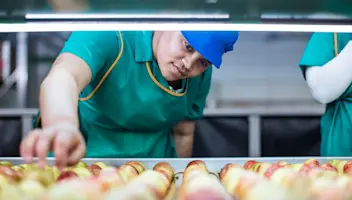Destacado en este post
Exploring ERP for the Food and Beverage Industry: Aptean’s Knowledge Repository
Exploring ERP for the Food and Beverage Industry: Aptean’s Knowledge Repository
Nov 30, 2022
Aptean Staff Writer
Are you a growing food and beverage business looking for your first enterprise resource planning (ERP) system? Or maybe your generic or legacy ERP solution is no longer meeting your requirements and you’re seeking a specialized replacement to remove workarounds and deliver purpose-built food industry functionality?
Wherever you are in your food ERP selection journey, chances are you’ve got a long list of questions and a quick Google search will reveal that there’s no shortage of resources out there to help you find the answers you need. But therein lies the problem. You’re busy with the everyday stresses of your food business, you simply don’t have time to wade through all the vendor and solution comparisons in addition to the industry body news websites to answer all of your queries.
Recognizing that reality, we’ve created this repository of resources broken down by the different stages along the way to implementation for a complete understanding of food enterprise resource planning (ERP) software.
So, no matter where your organization is on the path to this mission-critical goal, you’ll be able to learn more about ERP for the food and beverage industry and use the insights you gain to devise a sound approach going forward.
Feel free to use the jump links to the left to quickly navigate to the section most relevant to your situation or bookmark this page so you can come back as and when you need insights.
Stage 1: Initial Exploration
If you feel like you’re behind because you’re only now beginning to learn about ERP technology and the process of digital transformation, know that there’s no reason to let that hold you back in your efforts. These blog posts can help you get up to speed in no time so that your business can accelerate your plans for technological modernization.
Food and Beverage Industry Glossary - Before you dive in to some of the more complex and technology-specific content, it’s a good idea to acknowledge that even the most veteran of food and beverage professionals can use a refresher on the terminology used in today’s industry. We put together this comprehensive glossary for that purpose—you can even leave it open in a separate tab and simply refer to it when you need a reminder on what the latest terms and acronyms mean. (Be sure to bookmark this one as a browser favorite for future reference.)
When and Why Your Business Needs Food ERP Software - If you’re wondering whether your company is ready for a food ERP and how you can expect to benefit from the deployment of an industry-specific solution, check out this blog. We cover the key signs that it’s time to move forward with your initiative and the advantages that you’ll enjoy once you do so.
Food ERP Systems FAQ - Once you have a basic understanding of ERP software for food and beverage manufacturing and the purpose that it serves, you may find that you have many more questions—about who in your organization will be able to use it, what training will be required and what the implementation process will entail. We’ve got all those answers and more.
4 Compelling Reasons to Move Your Food and Beverage ERP to the Cloud - As you begin to picture your ideal path forward, one of the key decisions to make is the method of implementation that you’ll choose for your ERP for the food and beverage industry. While physical on-premise setups were dominant in the past, there are a few key reasons that you should consider moving to the cloud to achieve the best results in today’s business environment.
Stage 2: Researching ERP Features and Benefits
Whether you came to this post with working knowledge of ERP solutions or built up a better understanding of the basics by reading the above section, you’re now ready to explore the features and associated benefits of purpose-built software. This will help you get a feel for how the right system will work in practice and what impacts it can have on your organization.
General
Must-Have Features in a Food Industry ERP - For a high-level take on the functions of the best ERPs for the food and beverage market, you’ll want to navigate over to this blog. From inventory control and recipe management to allergen segregation and quality assurance, we cover those most crucial tools necessary for businesses like yours.
The Benefits of ERP for Food Businesses - Want to find out what advantages your business can unlock with the right ERP software? This post provides a rundown of the positive impacts that an industry-specific solution can have on a food and beverage company, including comprehensive supply chain visibility and greater efficiency thanks to automation.
Shedding Light on the Lesser-Known Benefits of ERP Software for Food Manufacturing - Another great thing about food and beverage industry ERPs is that if you dig a little deeper, you’ll find that there’s even more to love. We showcase the “hidden” advantages of advanced systems in this blog—some exclusive to Aptean Food & Beverage ERP.
Traceability
Food Traceability: How Technology Allows Food and Beverage Businesses to Meet the Challenge - Bidirectional tracking of ingredients and finished products all along the supply chain—better known as traceability—is among the top objectives for all food and beverage businesses and every bit as important as quality control and profitability. Dive into this piece to understand how ERP software helps you succeed on this crucial front.
Food Traceability Regulations - One of the key reasons that traceability is considered so vital is that it’s required by law, but it can be challenging to dig into the legislation and understand what’s required given your organization’s circumstances. We can help you make sense of it all with our post on understanding universal standards, regional differences and what it takes to ensure food safety and compliance.
Food Recalls and Traceability: Identifying Their Importance in Food Safety and Leveraging ERP Solutions for Improvement - Ensuring that your products are healthy and fit for consumption—as well as being fully prepared in the event that a recall is necessary—are additional components of a complete traceability strategy. This piece demonstrates how technology can enhance your approach to this critical task.
4 Steps to Create Excellent Food Product Traceability Procedures - While the aforementioned posts cover the “why” behind food and beverage traceability efforts, just as important is the “how,” meaning the best practices for keeping a complete picture of your goods’ movement and capturing all critical data. We get into the practical side of things with this post, making it a great read for even the most experienced industry veterans.
Lot Control for Food and Beverage Businesses and How ERP Powers Sound Practices - Here’s another post that speaks to the reality of managing traceability in modern operations. Because food and beverage manufacturers so frequently deal with large volumes of both raw materials and finished goods, they frequently group and track them in “lots” and “sublots,” so here we explain how to best handle them and why it’s so important to do so.
Other Operational Areas
6 Strategies for Better Product Shelf Life Management - While some food and beverage products have very wide windows of viability and are stable long after their date of manufacture, others require very close tracking of expiration dates in order to ensure only the freshest of goods arrive on store shelves and nothing goes to waste. Read the best tips we’ve got in this insightful blog.
Mastering Material Requirements Planning: 5 Keys for Food and Beverage Businesses - Correctly aligning your supply to demand and having what’s necessary to fulfill orders without ending up with excess ingredients that could spoil is a delicate matter requiring insight and forethought. By checking out this piece, you’ll have a better understanding of how to go about this process.
Batch Management: What It Is, Why It Matters and How ERP is Key to a Sound Approach - In this piece we define this vital practice, explain its importance and show you how ERP technology helps you succeed. Discover how you can reduce waste and improve the consistency your products’ quality with the right strategies.
7 Steps for Mastering Food Quality Control and How ERP Facilitates Excellent Results - On the subject of quality, there’s even more involved outside of batch management, including procuring good raw materials, dialing in your formulas and monitoring data in real time to identify deviations from acceptable standards. We break it down chronologically in this step-by-step guide.
How to Master Allergen Management in the Food Industry - This is the piece for you if you want to achieve your organizational objective of uncompromising food safety. Our post covers the ingredients with the highest levels of risk, pertinent regulations and critical control points, as well as the features that ERP software offers to aid in this complex task.
Preventing Operational Bottlenecks at Your Food and Beverage Business with ERP Solutions - Stoppages on your lines and other hold-ups in the production process put a damper on your ability to achieve maximum operational efficiency, which is more important than ever in an era of heightened retail demand and economic uncertainty. Learn about the role of software in this area by jumping in to this post.
Stage 3: Understanding How Food ERPs Serve Your Subvertical
Considering that most food and beverage companies specialize in one—or, at most, a few—product categories, at this point you’re probably interested to learn how ERP solutions suit your organization’s particular sector and its unique challenges. The following posts go in-depth on a variety of individual subverticals, and in doing so make clear the versatility and universal applicability of ERP software.
Food Distribution
How Food Distribution Software Can Help Your Business Conquer Key Concerns - If your organization is primarily engaged in moving products along the supply chain and managing logistics, you’ll want to know the most common pitfalls and how to avoid them. Learn the different ways that an advanced solution can help produce optimal outcomes, which is all the more crucial when food safety and customer satisfaction could be on the line.
The 5 Top Features to Look for in Food Distribution ERP Software - Want to know specifically which features you should prioritize in a distribution solution? We narrowed the list to a tight five so that you can quickly learn how technology can improve your inventory management, demand planning, supply chain visibility and more.
Bakery
Bakery ERP Features to Solve Your Business’s Key Concerns - Most of the features included in ERPs for the food and beverage industry are generally useful for bakeries, but some are tailor-made for the complexities of this particular category. This post covers this topic in detail, with attention to the nuances of the materials and finished products of the sector.
4 Big Challenges in the Bakery Industry and How the Right Software Makes All the Difference - For a topical take on the same space, check out this piece. We touch on both emergent trends—like supply chain disruptions and changing consumer preferences—as well as ever-present concerns like shelf life management and allergen control.
Why You Need Bakery Software and How Aptean Food & Beverage ERP Solves Sector-Specific Challenges - We put the spotlight on our own solution for bakery manufacturers here. Our solution has several functionalities that are regarded as must-haves for this subvertical, including backflushing and advanced pricing management.
Meat, Seafood and Poultry
How ERP Solutions Help Tackle the Toughest Meat Industry Challenges - The meat, poultry and seafood categories continue to be some of the most heavily regulated and scrutinized sectors, and as such companies operating within them need tools built for very specific procedures and processes. Learn all about this subject by reading this informative blog.
How a Meat and Seafood ERP Covers Your Catch Weight Management Concerns - Catch weight—also known as variable weight—is one of the most well-known complexities that meat, poultry and seafood businesses must deal with. We demonstrate how the right software can help you navigate this tricky matter in this piece.
The Key Features of Seafood ERP to Help Your Business Overcome the Sector’s Unique Challenges - As for those organizations operating specifically in the seafood space, we’ve got a list of features you won’t want to miss. Catch weight is again a primary topic, but so too are food safety, compliance and supply chain visibility, and we dive deep on each of those topics in this piece.
Dairy
Confronting 5 Major Challenges with ERP for the Dairy Industry - The world of dairy is different from any other thanks to the different classes of milk, the large variety of end products and safety considerations that manufacturers must take into account. Take a look at this blog to understand how the specialized software can help simplify these complex considerations.
How Dairy Manufacturing Software Improves Your Production Processes - By offering equipment integrations for component analysis, recipe controls for a range of products, bidirectional traceability and expiration management, an ERP for the dairy vertical can help your business streamline production and improve quality. Read more on the topic in this post.
Fresh Produce
Why Your Fresh Produce Business Needs a Specialized Produce ERP - In this piece, we explain why a generic solution just won’t cut it in a sector filled with nuances and highly variable circumstances. You need consignment capabilities, grower management tools and more, and just any solution off the shelf won’t necessarily have these critical features.
Facilitating Fresh Food Inventory Management with ERP Solutions - Considering the perishable nature of fresh produce, inventory management is one of the most vital features of ERP systems serving this sector. Learn more about both the “why” and “how” behind this crucial practice and the associated functions of ERPs by reading this blog post.
Beverages
5 Beverage Industry Trends and How ERP Solutions Enable Innovation - In this blog we look at five key trends that are shaping the industry - from the rise of premium drinks to the popularity of new packaging options - and how a specialized beverage ERP can help you conquer each one.
Choose Dedicated Beverage ERP Software for Sector-Specific Features - While food and beverage often get lumped together, you'll know that the beverage industry faces some distinct challenges and therefore requires dedicated functionality. Discover how beverage ERP software tailors general ERP features to the unique nature of beverage as well as providing purpose-built features to tackle your specific challenges.
Other Subverticals
Overcoming 3 Big Challenges in Frozen Food Supply Chain Management with Purpose-Built Software - The frozen food sector has seen a surge in popularity in recent years, beginning with the pandemic but extending into the current era of “new normal.” That makes navigating the challenges of the subvertical all the more critical, especially considering how important visibility and traceability are in this market.
Mastering Snack Manufacturing: 4 Keys for Safe and Efficient Production - As for the snack manufacturers out there, we haven’t forgotten you. With food safety and meeting increased demand high on your list of priorities, we know you’ll find plenty to munch on with this blog.
Stage 4: Getting to Know Trends and How ERP Technology Promotes Flexibility
As a food and beverage industry professional, you know well that change is a constant in this market, and your business must adapt to meet new demands for your best chances of success. Now that you’re this far along in your food ERP education, it’s time to satisfy your curiosity as to how the technology plays with emergent trends and can help your company stay up-to-date.
General
5 Food Industry Trends for 2023 that Demand Your Attention - Between rising costs, supply chain disruptions, the rise of big data and many more, the forces shaping today’s industry can push and pull your business in different directions and thus warrant a closer look. Our shortlist of trends goes in-depth on how each can be more easily mitigated or managed with ERP software.
Contract Manufacturing in Food and Beverage - With its prevalence skyrocketing in recent years, we take a look at what the contract manufacturing model is and how it can help improve your efficiency and profitability. In this post, you'll also find examples of food and beverage organizations that are already unlocking significant advantages using this method.
Consumer Trends
Celebrating Plant Power Day: The Latest in Plant-Based Food and Beverage Innovations - You’ve almost certainly caught wind of the rising popularity of plant-based products and their benefits for both consumer health and the environment. Earlier this year, we marked an international observance with a post focusing on just this subject.
Functional Foods: Nutritious, Delicious and Peaking in Popularity - Another niche in the food and beverage market is that of functional foods, or those items that can have positive benefits like better cognitive performance, immunity or gut health. For a complete dissection of the space and how ERP solutions can help you branch out into this territory, navigate to our deep dive.
Tailoring Your Food and Beverage Products for Popular Diets: Keto, Paleo and Low-Sugar Trends - With more consumers committing to specific dietary restrictions for the benefits promoted by their proponents, your organization can potentially appeal to those groups by targeting their very specific needs. This post covers three of the most prevalent diets and promising spaces for innovation.
Mashups, Crossovers and Flavor Fusions: Getting Novel in the Food and Beverage Industry - On the other hand, there are plenty of other shoppers who are seeking indulgence, comfort and nostalgia in the food and beverage products they buy. Check out some examples of the fun new offerings on store shelves and how ERP technology can help you get in on the action.
High-Pressure Processing of Food: Mitigating Risks Efficiently as Part of a Cohesive Food Safety Plan - Public health continues to be a topic of much discourse, and food safety is central to ensuring that consumers are safe and can trust the brands they support. Learn about high-pressure processing—a method of sterilization of food—and how it is particularly applicable for certain product categories in this blog.
Sustainability
Getting Serious About Sustainability at Your Food Business - Back in the spring, we invited readers to celebrate Earth Day with us, and the importance of environmental stewardship and corporate responsibility has only grown since then. Get the “why” and “how” behind going greener and leaner, as well as information on ERP’s beneficial features on this front.
5 Ways Food and Beverage Businesses Are Tackling Sustainable Sourcing - Becoming more sustainable as a food and beverage company starts at the very beginning of your supply chain, as you must ensure that your raw materials are produced in an environmentally responsible way if you’re going to really make a difference. Dive in to explore different ideas for going about this.
4 Ways Food and Beverage Businesses Can Shrink Their Carbon Footprint - Another part of the sustainability equation involves minimizing the greenhouse gas emissions of not just your own organization, but also your complete supply chain. For a breakdown of the best methods for reducing your environmental impact, jump into this post now.
5 Strategies to Reduce Food Waste and the Facilitating Features of Food ERP Solutions - With food production already being an energy-intensive process, spoilage of goods is seen not only as a loss of financial investments but also a major setback in efforts to achieve sustainability goals. That’s why you’ll want to check out our post detailing the steps you can take to reduce waste.
The Impacts of the Energy Crisis on the Food and Beverage Industry and How to Mitigate Them - Finally, for a more topical look at this issue and how current events are shaping the narrative, we suggest this timely blog. While no single business can solve this global problem, we’re all in it together, and this piece will help your company do its part.
Stage 5: Shortlisting and Selection
Once you’ve found answers for all your initial food ERP questions, it comes time to compare the solutions available, evaluate the vendors of those systems, create a shortlist and eventually select the right combination for you. This stage can be overwhelming, yet is crucial—after all, getting it wrong can cost your company significant time, money and effort. These next resources are all dedicated to helping you sort the wheat from the chaff and get to your final decision.
Comparing Food and Beverage ERP Solutions – What should you be looking for in both a solution and a partner? We explore some factors you should be considering in both evaluations and take a look at how to properly prepare your business for the process of implementation.
5 Qualities to Look for in Vendors of Software Used in the Food Industry – Understandably, a lot of organizations focus heavily on finding the right food ERP software, but overlook the importance of the vendor to the success of your implementation—both now and in the future. Whether it’s credibility, expertise, deployment options, ongoing support or product development, you need to know that the vendor you choose will be a dependable long-term partner.
7 Questions You Need to Answer Before Using an RFP for Food ERP Selection - A request for proposal (RFP) can be a useful tool for whittling down your options and evaluating the contenders on your shortlist, but before you start sending yours to vendors, it would be a good call to read up on the steps necessary to make sure you’re prepared internally.
Picking Your Path to Success: Navigating the Food ERP RFP Process - When you’re ready to put your RFP plans into motion, you need to make sure you know what’s in store for you and how you can best achieve the outcome you’re looking for—that is, finding the ERP solution that’s the right fit for your company. Our blog here will help you understand the best practices for this vital part of the journey.
Aptean: A Proven Provider of Expert Solutions
We’ve discussed a great breadth of content in this post, but there’s still more to engage with in the form of our interactive tools, including our Digital Transformation Assessment for Food & Beverage Businesses, Food and Beverage Sustainability Quiz and Food & Beverage Business Systems Health Assessment. We also have a comprehensive RFP template for readers who are at that stage of their digital transformation journey.
All of this is part of Aptean's continuing commitment to the food and beverage industry, evidenced by our teams’ decades of collective expertise and excellent knowledge of best practices. We are eager to act as a partner to each customer, helping to sketch out a project roadmap for implementation and providing support far after the go-live date.
What’s more, we offer and encourage flexible cloud deployments of Aptean Food & Beverage ERP on the Software as a Service (SaaS) model for full scalability, enhanced data protection, stronger cybersecurity and remote accessibility. Plus, our cloud food ERP solution is comprised of industry-specific technology built on the Microsoft Dynamics 365 Business Central platform, which gives the interface a user-friendly look and feel.
As your digital transformation progresses, Aptean will be there to support your growth with our full suite of food and beverage software solutions such as our product lifecycle management (PLM) solution, overall equipment effectiveness (OEE) system, route planning platform and business intelligence (BI) software. Working with a single, one-stop-shop provider helps keep your tech stack seamlessly connected and alleviates the strain on staff to work with multiple vendor teams and processes.
And for one final reason to choose us as the provider for all of your food and beverage business software needs, consider that we we recently received Frost & Sullivan's Customer Value Leadership Award in North American ERP Software for the Food and Beverage Industry. This award recognizes our deep understanding of the unique challenges faced by food manufacturers and distributors and our commitment to offer innovative and specialized solutions to address those challenges.
Now, if you’re ready to learn more about Aptean Food & Beverage ERP and how it can help drive better outcomes for your company? Contact us today or request a personalized demo.
Food Insights


Empieza a transformar tu empresa de alimentación y bebidas
Si estás listo para llevar tu negocio al siguiente nivel, nos encantaría ayudarte.






